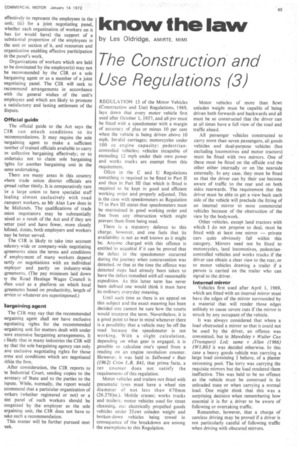know the law
Page 65

If you've noticed an error in this article please click here to report it so we can fix it.
by Les Oldridge, AMIRTE, MIMI
The Construction and Use Regulations (3)
REGULATION 13 of the Motor Vehicles (Construction and Use) Regulations, 1969, lays down that every motor vehicle first used after October 1, 1937, and all psv must be fitted with a speedometer with a margin of accuracy of plus or minus 10 per cent when the vehicle is being driven above 10 mph. Invalid carriages; motorcycles under 100 cc engine capacity; pedestriancontrolled vehicles; vehicles incapable of exceeding 12 mph under their own power and works trucks are exempt from this requirement.
Often in the C and U Regulations something is required to be fitted in Part II and then in Part III that which is fitted is required to be kept in good and efficient working order and properly adjusted. This is the case with speedometers as Regulation 77 in Part III states that speedometers must be maintained in good working order and free from any obstruction which might prevent them from being read.
There is a statutory defence to this charge, however, and one feels that its availability is not as well known as it might be. Anyone charged with this offence is entitled to acquittal if it can be proved that the defect in the speedometer occurred during the journey when contravention was detected, or that at the time the offence was detected steps had already been taken to have the defect remedied with all reasonable expedition. As this latter term has never been defined one would think it must have its ordinary everyday meaning.
Until such time as there is an appeal on this subject and the exact meaning has been decided one cannot be sure how the courts would interpret the term. Nevertheless, it is a good point to bear in mind whenever there is a possibility that a vehicle may be off the road because the speedometer is not working. With a slight calculation, depending on what gear is engaged, it is possible to calculate one's speed from a reading on an engine revolution counter. However, it was held in Sellwood v Butt (1962) Crim f,.R. 841, that prima facie, a rev counter does not satisfy the requirements of this regulation.
Motor vehicles and trailers not fitted with pneumatic tyres must have a wheel rim diameter of not less than 670mm (26.378)in.). Mobile cranes; works trucks and trailers: motor vehicles used for street cleansing, etc: electrically propelled goods vehicles under 25cwt unladen weight and broken-down vehicles being towed in consequence of the breakdown are among the exemptions to this Regulation. Motor vehicles of more than 8cwt unladen weight must be capable of being driven both forwards and backwards and all must be so constructed that the driver can at all times have a full view of the road and traffic ahead.
All passenger vehicles constructed to carry more than seven passengers, all goods vehicles and dual-purpose vehicles (but excluding locomotives and motor tractors) must be fitted with two mirrors. One of these must be fitted on the offside and the other either internally or on The nearside externally. In any case, they must be fitted so that the driver can by their use become aware of traffic to the rear and on both sides rearwards. The requirement that the driver must be able to get a view back each side of the vehicle will preclude the fitting of an internal mirror to most commercial vehicles because of the obstruction of the view by the bodywork.
Other vehicles, except land tractors with which I do not propose to deal, must be fitted with at least one mirror — private cars quite obviously fall within this category. Mirrors need not be fitted to motorcycles, land locomotives, pedestriancontrolled vehicles, and works trucks if the driver can obtain a clear view to the rear, or to motor vehicles drawing a trailer if a person is carried on the trailer who can signal to the driver.
Internal mirror
Vehicles first used after April 1, 1969, which are fitted with an internal mirror must have the edges of the mirror surrounded by a material that will render those edges unlikely to cause severe cuts if the mirror is struck by any occupant of the vehicle.
It was always considered that where a load obstructed a mirror so that it could not be used by the driver, an offence was committed, but in Mawdsley v Walter Cox (Transport) Ltd; same v Allen (1966) IW LR63 it was decided otherwise. In this case a heavy goods vehicle was carrying a large load consisting I believe, of a plaster swimming pool. The lorry was carrying the requisite mirrors but the load rendered them ineffective. This was held to be no offence as the vehicle must be construed in its unloaded state or when carrying a normal load. One might think that this was a surprising decision when remembering how essential it is for a driver to be aware of following or overtaking traffic.
Remember, however, that a charge of careless driving may be proved if a driver is not particularly careful of following traffic when driving with obscured mirrors.
















































































































